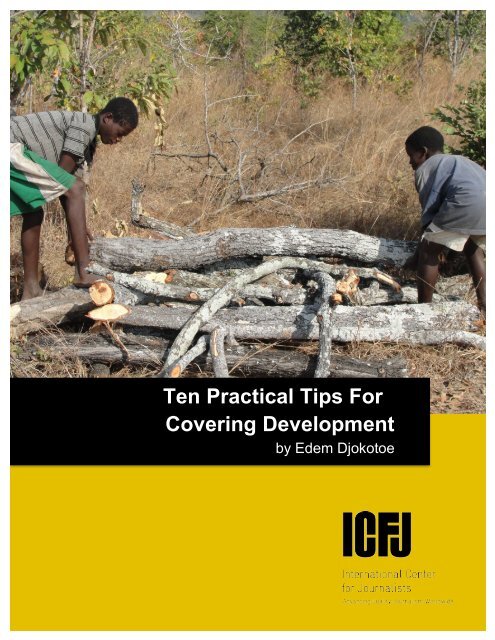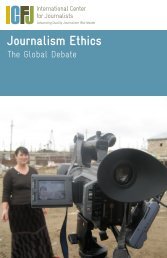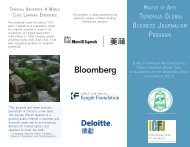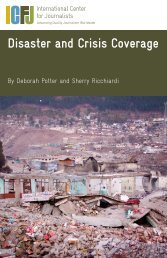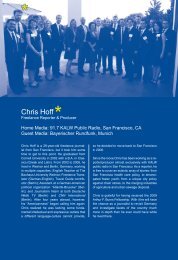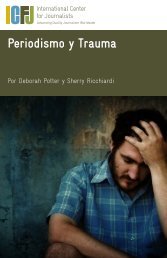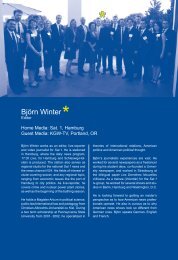Download PDF - International Center for Journalists
Download PDF - International Center for Journalists
Download PDF - International Center for Journalists
You also want an ePaper? Increase the reach of your titles
YUMPU automatically turns print PDFs into web optimized ePapers that Google loves.
Ten Practical Tips For<br />
Covering Development<br />
by Edem Djokotoe<br />
0
© Copyright 2013. All rights reserved.<br />
<strong>International</strong> <strong>Center</strong> <strong>for</strong> <strong>Journalists</strong><br />
1616 H Street, NW, Third Floor<br />
Washington, DC 20006 USA<br />
Tel: +1 (202) 737-3700<br />
Fax: +1 (202) 737-0530<br />
www.icfj.org<br />
1
n n n<br />
By definition, development stories are big news in<br />
developing countries. The problem is media reports are<br />
typically just government announcements of infrastructure<br />
development – roads, bridges, hospitals, etc. – and official<br />
claims that lives will improve. Those articles turn off the<br />
reading and viewing public, and that has some editors<br />
pulling their staffs off this important coverage.<br />
But there can be much more to these stories. Here are 10<br />
tips from Edem Djokotoe, Knight <strong>International</strong> Journalism<br />
Fellow in Malawi in 2010 and 2011. Djokotoe’s advice<br />
stresses less jargon and more people, impact and original<br />
reporting. It reminds us that we are writing <strong>for</strong> ordinary<br />
people – not development “experts” – to show them the<br />
implications of the events unfolding around them. It leads<br />
to creative, rich stories full of in<strong>for</strong>mation and knowledge.<br />
1.<br />
n n n<br />
2
1. Broaden the development story<br />
When journalists assume “development” means government projects, they produce<br />
dreary, standard fare, like this in the African media:<br />
Government through the Local Development Fund (LDF) on Friday launched an<br />
urban structure plan <strong>for</strong> the K400 million Chitekesa Growth Centre in Phalombe.<br />
But a broader take on the topic can turn up hundreds of stories behind practically every<br />
deserted village, dried up river, closed factory, hut and homestead, market stall, farm<br />
and even classroom.<br />
One journalist looked beyond government press releases to find a development story in<br />
the wine-making business of a biochemist and his wife, in their backyard in the capital<br />
city of Lilongwe. Using their salaries as capital, the couple started making wine from<br />
local fruits. The article used this startup to cover several larger development challenges<br />
at play in the country, such as, the difficulty of scaling up a cottage industry to an<br />
enterprise that could create jobs and new exports when taxes are high and a shortage<br />
of <strong>for</strong>eign currency makes it hard to import necessary materials.<br />
2. Humanize the development story<br />
For too long, development stories have been lifeless and predictable. You can give<br />
these stories impact by putting people in them – because ultimately, development is<br />
about changing lives, and that’s what readers and viewers relate to.<br />
One series of newspaper articles used a dramatic childbirth story to cover the collision<br />
of health and infrastructure problems in Malawi. The articles explained the government,<br />
in an ef<strong>for</strong>t to bring down high maternal mortality rates, banned the use of traditional<br />
birth attendants and directed pregnant women to go to medical centers to deliver. But<br />
that meant long walks <strong>for</strong> women in remote areas without good roads and bridges – like<br />
Lusita Belenado of Gadama, whose nearest center was 20 kilometers away. Belenado<br />
didn’t quite reach it. Her daughter was born – with no medical care – on the banks of a<br />
river en route.<br />
This human story did have impact. The series prompted Malawi’s president at the time,<br />
Bingu wa Mutharika, to lift the ban on traditional birth attendants and to promise to train<br />
them, so they can provide maternity services where there are no hospitals or clinics.<br />
3
3. Focus on ordinary people, not big shots<br />
Ordinary people are almost<br />
invisible in the media in developing<br />
countries, though their numbers far<br />
exceed those who make the news,<br />
grab headlines and hog the media<br />
spotlight every day. Their voices<br />
are seldom heard, their stories<br />
seldom told. When they do get<br />
reported, they are projected either<br />
as victims, beneficiaries of<br />
government largesse, a mob given<br />
to riotous, antisocial behavior or a<br />
cadre of criminals. But as events<br />
from North African capitals such as<br />
Tunis and Cairo showed, ordinary<br />
people can be a powerful <strong>for</strong>ce<br />
capable of bringing about political<br />
and social change.<br />
Pregnant women await treatment at a busy health center in<br />
Malawi.<br />
It is important <strong>for</strong> journalists reporting development to focus on ordinary people <strong>for</strong> three<br />
main reasons. Firstly, they bear the brunt of the impact of government decisions and<br />
suffer most from deprivation arising from public expenditure priorities. Secondly, they<br />
make up the largest sector of the population. Thirdly, in journalism, the sheer weight of<br />
numbers counts <strong>for</strong> something.<br />
4
4. Look <strong>for</strong> unusual angles<br />
One way to show how diverse the development story can be is to pursue unusual story<br />
angles. A standard development story, based on a Malawi government decision to<br />
upgrade a town to a city, makes great claims of progress, like this one does:<br />
The Malawi government declared the town of Zomba a city on 9 March 2008. As<br />
part of the urban development plan <strong>for</strong> the new city, it wants to rehabilitate the<br />
60-kilometre stretch from Blantyre, the commercial capital of Malawi, to Zomba.<br />
Government says the road project will open Zomba up to a whole range of social<br />
and economic opportunities, including access to markets and to inputs and make<br />
it a strategic corridor <strong>for</strong> the transportation of goods to neighboring countries.<br />
But the Weekend Nation hatched the idea to explore the cost of progress on Zomba –<br />
from the point of view of residents. Suddenly the development didn’t seem like such a<br />
great deal. The story showed, <strong>for</strong> example:<br />
• Many residents wanted a say in how their city develops, and they felt slighted by the<br />
president and the city assembly making decisions unilaterally.<br />
• Thirty-eight families would lose their homes and 15 traders would lose their shops to<br />
the project.<br />
• One hundred twenty-five hectares of agricultural land and 15 of natural trees would<br />
also be lost.<br />
5
5. Report from the field<br />
Much of what passes <strong>for</strong><br />
journalism today in the African<br />
media is actually “churnalism” –<br />
simply churning out press<br />
releases, wire stories and prepackaged<br />
material as news. It’s<br />
cheap and eases deadline<br />
pressures. But it’s not possible<br />
to report development by<br />
remote control, at your desk.<br />
You need to get out and go see<br />
what’s happening <strong>for</strong> yourself.<br />
You need to meet real people<br />
and <strong>for</strong>m impressions. Legwork<br />
is a reporter’s reality check.<br />
For instance, only legwork<br />
revealed the truth about the<br />
Edem Djokotoe on a reporting trip in Malawi, where he<br />
trained journalists to produce in-depth and investigative<br />
pieces.<br />
extent of drought-induced famine in southern Zambia in 2002. The provincial minister<br />
told the nation that the government had distributed relief food throughout the affected<br />
areas and that to the best of his knowledge every household had been provided <strong>for</strong>. But<br />
first-hand reporting resulted in a different story: When I traveled there with a team of<br />
journalists, we found fresh graves of some villagers who had died from hunger, whole<br />
families subsisting on wild roots, and thousands of people who had not received relief<br />
supplies <strong>for</strong> five weeks.<br />
6
6. Use news events to explain issues<br />
Obviously, <strong>for</strong> journalists the<br />
issues worth reporting are<br />
those suggested by the news<br />
or raised by events in the<br />
news. The most practical way<br />
to give such issues currency,<br />
topicality and newsworthiness<br />
is to hook them onto a current<br />
event or development in the<br />
news, or in the jargon of<br />
journalism, a news peg.<br />
News pegs give issues their<br />
immediate relevance. Without<br />
them, the issues journalists<br />
report and write about risk<br />
being hypothetical and<br />
academic.<br />
Women sell charcoal by the roadside in Chifunga Neno,<br />
Malawi.<br />
7
7. Avoid technical jargon<br />
The world of development, like every specialty field, is abuzz with jargon and strange,<br />
insider expressions. If you’re not careful, your writing will become infected with phrases<br />
like: participatory development models, grassroots initiatives, livelihood enhancement<br />
programs, income generating activities (IGAs), and even “mainstream stakeholder<br />
engagement through shared learning plat<strong>for</strong>ms.”<br />
The source is a motley crew of “experts” – development workers, development<br />
specialists, and international development advisors.<br />
One reason development stories have little appeal is that they tend to be full of technical<br />
jargon. A policy of avoiding jargon has another advantage: It <strong>for</strong>ces you to focus on the<br />
concrete. At those rare times when you have to use technical phrases, be sure to define<br />
them clearly and simply.<br />
8. Use statistics carefully<br />
<strong>Journalists</strong> often use statistics as objective truth, proof of a point or support <strong>for</strong> a<br />
conclusion. The fact is, statistics come from studies, and you have to assess the validity<br />
of each one: Who conducted and paid <strong>for</strong> the study? What did it set out to measure? If it<br />
was a poll, who were the respondents? How were they questioned?<br />
Take the case of one general election in Zambia: Two government-owned dailies<br />
published polls showing the ruling party head and shoulders above all others. But a<br />
privately owned daily had a poll showing the biggest opposition party as the most<br />
popular. This raises questions about these pollsters and these newspapers. And it<br />
challenges the journalist: Which polls do you publish?<br />
When it comes to development, journalists sometimes rely on statistics from the big<br />
international organizations like the World Bank, <strong>International</strong> Monetary Fund or various<br />
UN agencies. One that comes to mind is the number of people in developing countries<br />
who live on less than US $1 a day. But what does this mean? In my travels around the<br />
African countryside, I have seen many households where the people make very little<br />
money. But the houses they live in are their own. They have cows, goats, and sheep,<br />
grain in their barns and their own land, which have value. A good journalist provides<br />
context <strong>for</strong> statistics and explains what they mean in that particular context. A dollar<br />
means one thing in an urban setting where one must buy every drop of milk and another<br />
in the countryside where the people have cows.<br />
8
9. Follow up stories<br />
Development is a slow, evolving process that extends far beyond a 24-hour news cycle.<br />
<strong>Journalists</strong> need to track it over time. To keep people abreast of important development<br />
– to have impact – you have to stay on top of the story. And the best way to do that is<br />
follow up with more stories.<br />
One successful example started with this story:<br />
On 23 October 2010, then-President Bingu wa Mutharika launched the Nsanje<br />
World Inland Port project on the country’s largest river, the Shire. The project<br />
was intended to give landlocked Malawi direct access to the Indian Ocean<br />
thereby reducing the cost of transporting the country’s imports and exports<br />
through Mozambican ports. It was estimated that the port would reduce Malawi’s<br />
import bill by US$175 million when completed.<br />
Fourteen months later, The Nation newspaper followed up with this report:<br />
Locals, not seeing the immediate use <strong>for</strong> the facility, are literally dismantling it<br />
bolt by bolt, metal by metal, wire by wire and concrete by concrete. “People are<br />
melting the bolts and making spoons and pots from them,” said one local who<br />
fishes in the dock.<br />
Without this follow-up, Malawians would not have known that Mutharika’s dream had<br />
turned into a nightmare.<br />
10. Read widely<br />
By reading widely, journalists can cover development with a great deal more authority,<br />
depth and insight. By staying in<strong>for</strong>med, you discover new facts and ideas, fresh<br />
perspectives and conflicting arguments. By casting one’s reading net widely, you also<br />
broaden your sources.<br />
Even fiction has value, offering depictions of larger, timeless expressions of the human<br />
condition. Nonfiction – newspapers, trade journals, and professional and general<br />
interest magazines – usually provides more practical in<strong>for</strong>mation about the current state<br />
of affairs.<br />
All kinds of reading should be grist <strong>for</strong> a journalist’s mill.<br />
9
About the Author<br />
Edem Djokotoe is a senior journalist and media trainer based in Lusaka, Zambia. In<br />
2010 and 2011, he was a Knight <strong>International</strong> Journalism Fellow leading a project to<br />
create consistent in-depth coverage of poverty and development issues in Malawi.<br />
Originally from Ghana, he has lived and worked in Zambia <strong>for</strong> more than two decades.<br />
He has worked at Zambia’s two leading media training institutions, Evelyn Hone College<br />
and the Zambia Institute of Mass Communication, and is also a newspaper columnist,<br />
writing twice a week <strong>for</strong> The Post since November 1995.<br />
n n n<br />
About the <strong>International</strong> <strong>Center</strong> <strong>for</strong> <strong>Journalists</strong><br />
The <strong>International</strong> <strong>Center</strong> <strong>for</strong> <strong>Journalists</strong> advances quality journalism worldwide. Our<br />
hands-on programs, including the Knight <strong>International</strong> Journalism Fellowships, combine<br />
the best professional practices with new technologies. We believe that responsible<br />
journalism empowers citizens and holds governments accountable. For more<br />
in<strong>for</strong>mation, go to www.icfj.org.<br />
Photos by Bobby Kabango, Nation Publications Limited<br />
Ten practical Tips <strong>for</strong> covering<br />
10


